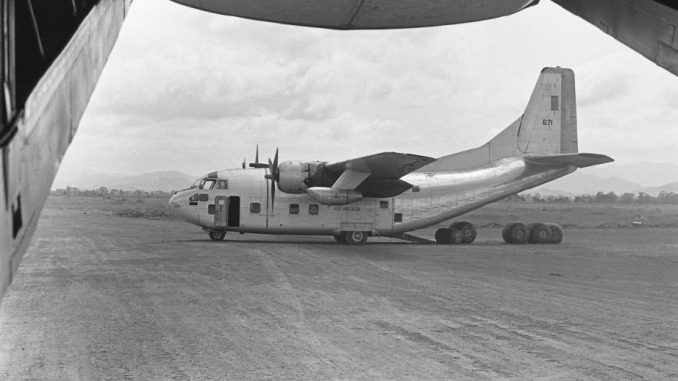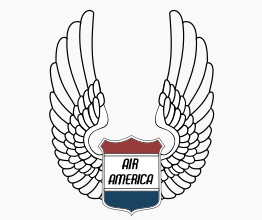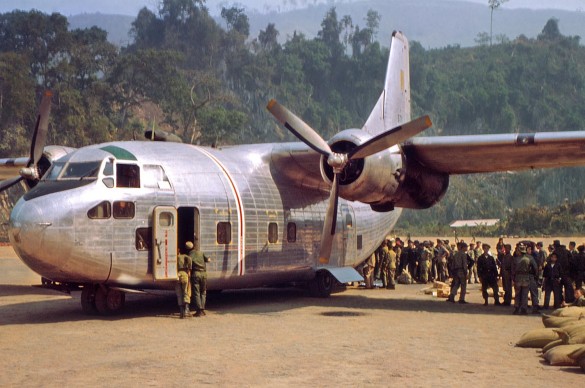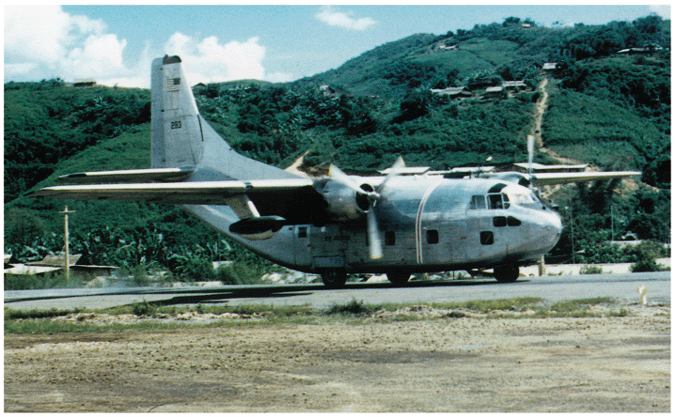
By Chris Henry
During the war in Vietnam, there was an airline that flew some of the most harrowing missions ever taken on by a group of this type, and over hostile territory. Because of this, they gained the title of “World’s Most Shot at Airline”. This airline had more than 30 twin-engine cargo aircraft, two dozen STOL aircraft such as the Helio Courier, more than 30 helicopters, and more than 300 employees. Their company name Was Air America, and their motto was “Anything, Anywhere, Anytime, Professionally”.

Neil Hansen started his interest in aviation at a young age. Like so many of us in aviation, his passion for aviation started as a kid building models. Then he started flying the control line planes until he was old enough to get a job. His first job was at the local airport washing planes. “You could make some really great money cleaning planes at the airport, and if I did it right I could do 3 cubs in an hour.” He took part in what he was making and used it to take flying lessons. It was not long before he had earned his license and bought his first airplane, a Cessna 140. He would later go on to purchase a Mooney Mite and fly it on an amazing journey to Jamaica. He would later go on to do a large amount of executive flying eventually flying for the Teamsters and the personal pilot to Jimmy Hoffa. “It looked like Mr. Hoffa was going to be going away for a while, and I figured I had better find something else. There was an ad in the newspaper for Air America. I applied and a gentleman called me back. He sounded pretty unimpressed and said that they were not really looking for any more pilots. So I went on about my business.” More than a week had gone by and Neil found himself at Meigs Field in Chicago. “I was paged to a phone in the field manager’s office and on the other end of the line was a gentleman for Air America. He asked if I could fly well and if I liked to drink. I said yes to both and they asked me if I could report right away. I said that I had to give my company notice and needed longer. Besides I didn’t have a passport and that would take a while.” They had Neil go down right away and put in his paperwork for his passport. In 3 days he had his new passport in hand. One day while flying some of the lawyers for the Teamsters, he mentioned that they were going to be losing him as he had accepted a new job. When asked where he was going he started Air America. The lawyers replied very casually with, “Oh the CIA”. “As you can imagine, this was a big surprise to me”.

“I was treated first class during my entire trip from the United States to Asia. So good in fact that I was starting to worry about what was ahead”. Neil attended indoctrination and background checks and also was issued a Chinese License. “Many of the aircraft that they had in their company were built by the Chinese, and would not be legal in the U.S.” Neil found himself flying some of the big iron with the company. Most of his time was in the DC-6, C-123, C-46, DC-3, and the DO-28. “They would strip all of the markings off of my DC-6and I would depart around 2:00 AM. We would fly 500 feet off of the published routes, and fly for about 10 hours carrying munitions down to Laos. All of this was done with absolutely no flight plan!”
There were really no navaids. Most of the flying was done with dead reckoning. One of the biggest challenges would of course be the weather. The weather would change very fast, and when the monsoon season would come it would be unplayable at times. Neil had some great adventures. Many of them are depicted in the 1990 movie starring Mel Gibson and Robert Downey Jr. “There was a lot of Hollywood in that movie. One of the things mentioned there is that we carried drugs. There is no way. We never carried drugs anywhere. The only time drugs might have been carried is if it was in someone’s pocket that was on our plane. Some of the things they got right. I would take people on their orientation flights and while they were flying pull out a coloring book and crayons and start coloring. I used to have my plane blessed by Buddhists every day and I even became a Buddhist Monk. I figured that if I was going to live among these folks, which I had better make an attempt to fit in with their culture.”

When asked if there was one day that stood out during his time with Air America he said that it would have to be the day he crashed 3 times in the same day. The event took place near a base in Pac Say near the Ho chi min Trail. He was flying a C-123 loaded with ammunition that he was carrying to resupply two different firebases. “We made it to the first base with no issues, and just as I hit the button to turn the jump light green in the back to signal the kickers to launch the cargo, we started taking anti-aircraft fire. The kickers were personal who would stay in the back of the plane and tend to the cargo, where many times locals that would work for us.” Neil questioned them and they reported seeing orange balls coming up at them. Neil determined what kind of weapon was shooting at them and then avoided it. He returned to base and reported to his case officer that there was an intense anti-aircraft fire near the drop zone. The case manager said that there was no known enemy activity in the area. “Well, I knew right then that someone was lying to me.” At Neil’s urging the case officer agreed to send a fire team out to sweep the area. After a few hours, the team reported back that nothing was out there and that it was clear for us to continue the flight. I knew we were going to be in a fight, so I requested two helicopters on standby.” The Huey’s took off half an hour early/ Neil then departed in his C-123 and headed for the Drop zone. “Picture shooting skeet. I figured if I stayed low and fast until the last second, I would be a harder target to hit. So I kept down low just above the trees. Right as we arrived at the DZ, I pulled up and dropped our cargo. AS the cargo dropped we started taking fire. We got hit pretty hard. The airplane shuddered under the fire. You could hear the shrapnel hitting the belly of the Provider. The plane kept wanting to roll right, so I hard to start the jet and get it up to 100% on that side to keep it from rolling over. . I asked our co-pilot who was a nervous newer guy to go back and see how bad the damage was. He reported back that both ailerons were in the full-up position. I knew we were going to have to bail, so I headed toward this old Japanese airstrip. We couldn’t land there, but it would be a safe area to bail. As I approached the field, I told my co-pilot to get ready. He went to the back of the aircraft, and as I was about ready to give the signal to jump, he wandered back to the cockpit looking for his tack vest. I was sort of startled by this and gave it to him. Then I called the kickers on the intercom and told them that when he got back there to take that vest off of him and throw it out of the door. If he tried to put it on over the parachute, it wouldn’t open properly. The problem was as this all happened, we had overflown the base. So I had to turn around to try it again. As we lined up on the base for the second time, once again about to signal to the crew to jump, I could see something out of the corner of my eye. It was my co-pilot back in the cockpit again. I asked him in a very matter-of-fact tone what he was doing back in the cockpit. He stated that he had forgotten his Nikon camera. I handed him the camera, and then punched him and he fell back out of the cockpit. By this time we had once again overflown the base, and I had to line up for the third time. This time I called the kickers again and told them to throw him out. On this attempt, everyone bailed. My co-pilot wasn’t sure how to use the parachute and was trying to pull the ring the wrong way. He eventually did get it opened, but he lost some altitude first. Now it was my turn. The plane began to come apart, and I bailed in time to watch it crash. After a short wait, a helicopter came to pick us up. Inside this helicopter was a guy who had been shot, and was throwing up between his feet. I knew how he felt. They stuck their tail rotor through some brush and peppered me with branches. We took small arms fire on the way out, and after a short hop had to crash land. We did so and a second helicopter landed about 50 yards from us to pick us up. We couldn’t figure out why since we had a wounded man that we were lugging with us, but we made our way to the helicopter. When questioned about why they landed so far from us the pilot responded very matter in fact like, “Well you guys were in a minefield.” We had just about made it back to base in this helicopter when it ran out of gas and we had to auto-rotate into trees. As I walked into the base that night, still armed with my Uzi, that case officer that sent us up there saw me coming and said that he would go for the beer. We never saw him again.”
“I really loved flying the DC-3. We would take it in and out of 1,500-foot strips. It was just a great airplane. I had a great friend named Bill Pruner that I used to fly with a lot. Bill had been a corporate pilot of Cummings Diesel out of Indianapolis. One day Bill and I had planned on taking a DC-3 out flying for a while. Right before we left, I received word that there was some mix-up on where I was supposed to be. So I could not go. Sometime later I was in the radio shack and we got word that Bill’s DC-3 had taken fire and was wounded. Bill had taken a round through the thigh but was still in control of the plane. He fought to find a place to crash land the airplane and managed to get it down and secure on a rice paddy. Everyone was ok, and they were tending to his wounds. We actually had a helicopter less than 20 minutes out and it looked like it was going to end up alright after all. All I could do is sit in the radio shack and listen to the reports coming in. The helo showed up and started taking fire from VC who were in the airplane and throwing grenades. We sent in a gunship that took out the VC and when the rescue helicopter returned they found that everyone inside the airplane had been killed and tortured. There was a report that one person in an Air America uniform was seen being led away from the crash and I hoped that it was my friend Bill. As the rescue helicopters returned to our base, I went out to meet them and pulled back the sheet over one of the bodies. It was Bill. Had things happened differently that day, I too could have been on that flight.” What is not known to many is that 242 people lost their lives working for Air America. To this day none of them are eligible for veteran benefits. This is a wrong that deserves correcting.
Click HERE to visit the official website of Air America.


THE PICTURES? THE THIRD PICTURE IS A DC-3?? WAS IT WHAT WE CALLED A CARIBU? IN VIETNAM? LAND AND TAKE OFF SHORT DISTANCE! NEVER HAD A RAP OR DOOR ON THE BACK; WE WOULD RUN AND JUMP IN OUT IN THE JUNGLE OR BUSH; BOY YOU GRABBED ON THE SIDE RAIL AND HELD ON, HE WAS GOING STRAIGHT UP!! OR CLOSE TO IT; K TRP, 3RD SQD. 11 CAV; 66-67
THANK YOU;
All the pictures are of C-123 Providers
Farrell… All are C-123’s. We had C-47’s (the military version of the DC-3), and they were “Gooney Birds” not “Caribous”. The C-7 was the Caribou. We had those too. The short take-off, and landing (STOL) were Helio Couriers, and Pilatus Porters, quite a bit smaller than these… Thanks for your interest in AAm.
After being furloughed from Pan Am due to the fuel crunch.
I was interviewed in DC for a job with Air America back in 1970. On arrival at the location, a briefing officer said I had a choice of base, Formosa or Northern Bangcock.
He showed me pictures of both locations. I would have PX and commissary privileges but could not live on base.
I had 24 hrs to make a decision . Plus the Insurance and vacation benefits.
After discussing this with my wife (our baby girl was only 6 mo. old.
I turned down the job offer.
The C123 was a Caribu ..The DC 3 was a DC3 My father flew both along with the Porter. He was a pilot for Air America from 63 to 74. I was fortunate to get to fly in the 123 many many times when teaching the kickers and landing and takeoffs in some scary mountain tops.
Guy… The C-123 was a “Provider”. Caribou was the C-7. We didn’t fly DC-3’s, they were C-47’s, which is the militarized version of the DC=3.
GREAT story Neil, makes me think of about 100 more almost as good.